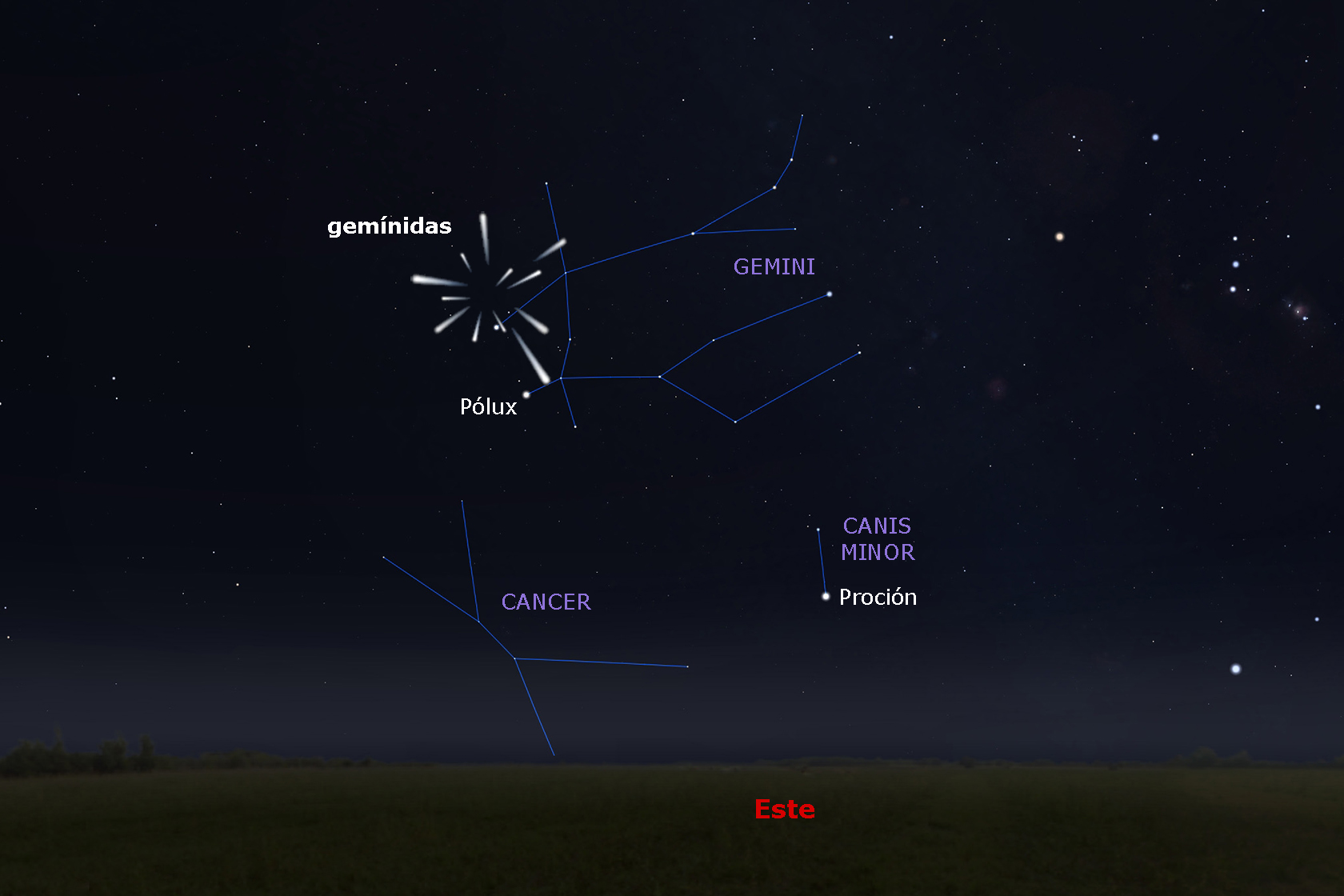Información astronómica

Gemínidas
La lluvia de las gemínidas es una lluvia de meteoros (comúnmente llamados "estrellas fugaces") que sucede todos los años hacia el 14 de diciembre.
Las gemínidas tienen una tasa de actividad por encima de los 120 meteoros por hora y una velocidad de 35 kilómetros por segundo durante varios días, lo que las convierte en una de las lluvias más activas del año junto a las cuadrántidas de enero y las perseidas de agosto. Tras las gemínidas, las siguientes lluvias de meteoros serán las coma berenícidas del 19 de diciembre y las úrsidas el 22. Ambas tendrán una tasa de actividad mucho más baja que las gemínidas, de entre 3 y 10 meteoros por hora.
Las gemínidas son visibles desde todo el hemisferio norte entre el 4 y el 17 de diciembre aproximadamente. Su momento de máxima actividad tendrá lugar en las noches del 13 al 14 de diciembre, cuando podremos observar hasta 150 estrellas fugaces por hora.
Para observadores a nuestras latitudes, 40º norte, el radiante de las gemínidas se sitúa por encima del horizonte desde una hora después del anochecer hasta el amanecer.
¿Qué se espera en 2025?
En 2025 el pico de actividad estará centrado en la noche del 13 al 14 de diciembre, en torno a las 9 de la mañana de tiempo oficial peninsular. Se trata de la lluvia más fuerte del año, con un máximo bastante amplio, por lo que toda esa noche tendrá buena visibilidad, siempre que las condiciones meteorológicas lo permitan. La Luna estará en fase menguante, a medio camino entre el cuarto y la fase nueva, por lo que la observación es mejor antes del orto lunar, hacia las 3 de la madrugada.
¿Por qué suceden?
El origen de las gemínidas fue un misterio durante siglos pues no se sabía asociar la lluvia de meteoros con ningún cometa periódico conocido. En el año 1983, el telescopio espacial de infrarrojos IRAS (lanzado por la NASA) identificó un asteroide, llamado Faetón, y al estudiar su órbita, se concluyó que era este asteroide el que causaba la lluvia de estrellas. Se trata pues de un caso peculiar, pues prácticamente todas las otras lluvias de meteoros conocidas están causadas por cometas.
Los astrónomos especulan con la idea de que Faetón pudiese ser hoy un cometa extinto y que los fragmentos que forman las gemínidas pudiesen haber sido desprendidos hace siglos, cuando Faetón aún tenía actividad cometaria. Como todos los años por estas fechas, la Tierra atraviesa un anillo poblado con aquellos fragmentos desprendidos de Faetón. Cuando uno de esos fragmentos (o meteoroides) entra en contacto con la atmósfera terrestre, se calcina por la fricción con el aire creando así el resplandor luminoso que conocemos como meteoro o estrella fugaz. Típicamente, los meteoros más comunes que observamos a simple vista los producen partículas de unos milímetros a unos centímetros de tamaño que se queman a unos 100 kilómetros de altura.
La correspondiente lluvia de meteoros parece tener un único centro de origen, un punto del que parecen surgir todas las estrellas fugaces. Ese punto se denomina "radiante" y su localización se utiliza para nombrar a la lluvia de estrellas. Así pues, las gemínidas tienen su radiante en la constelación de Géminis.

El 'radiante' de las gemínidas.
¿Qué hacer para ver las gemínidas?
El lugar de observación puede ser cualquiera con tal de que proporcione un cielo oscuro. Es preferible observar desde un lugar que tenga pocos obstáculos para la vista (como edificios, árboles o montañas), y no utilizar instrumentos ópticos que nos limiten el campo de visión. Aunque las gemínidas parecen venir de la constelación de Géminis (de ahí su nombre), se pueden ver en cualquier parte del cielo. Conviene dirigir la mirada hacia las zonas más oscuras, en la dirección opuesta a la posición de la Luna si la observación se realiza cuando esta esté presente. Lo más cómodo es tumbarse y esperar a que la vista se acostumbre a la oscuridad.
